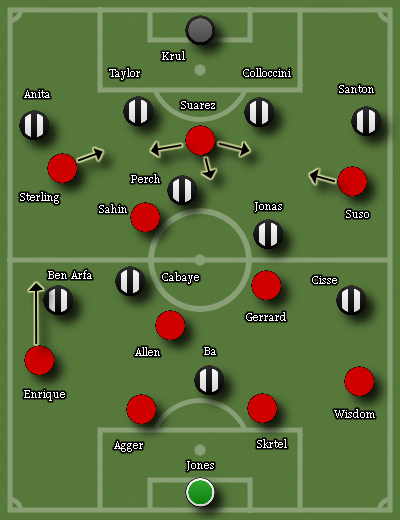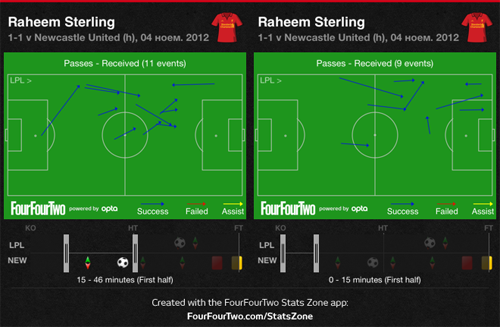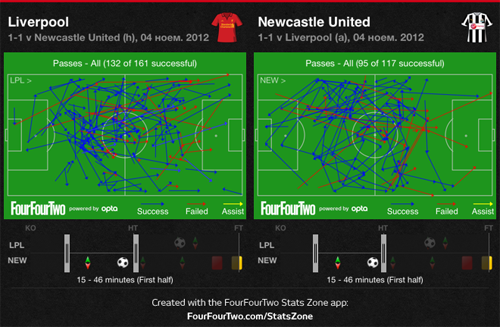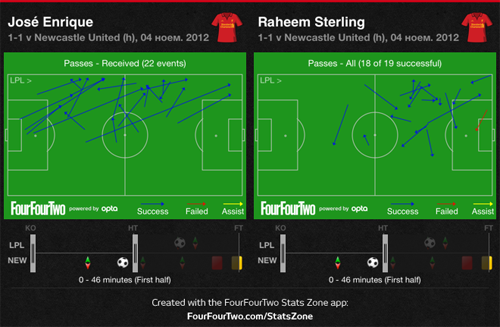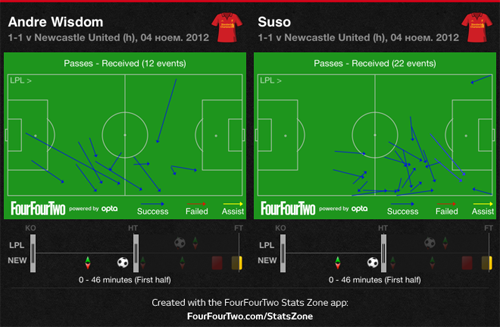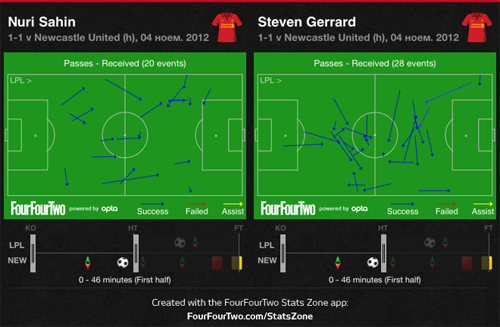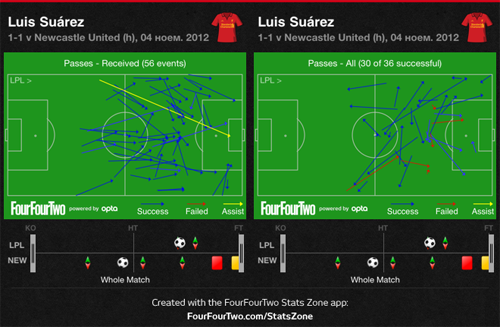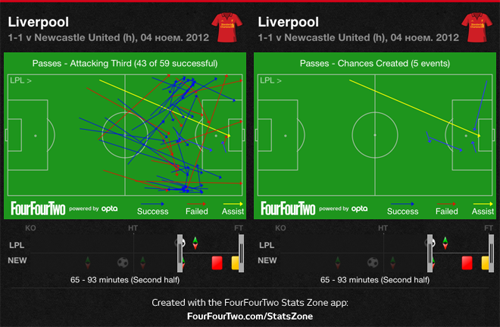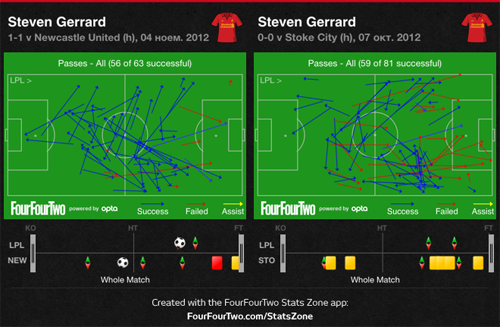By Mihail Vladimirov.
As expected Reina and Johnson were injured, so Jones and Enrique started instead for Liverpool. Everyone else who featured in the past several league matches started, and even Sterling and Suso reverted to their usual positions on the left and right flank respectively.
For Newcastle there were no major surprises either, except for the fact that Anita started on the right and Simpson on the bench. Ba was fit to feature and Steven Taylor was restored alongside Coloccini.
Formations
Rodgers selected his usual 4-2-3-1 shape without any surprises, whilst Pardew opted for a more defensive-minded 4-1-2-3 (which was more like 4-1-4-1 most of the time, given Liverpool dominated the ball). The surprise came from the fact it was Cisse – and not Ba – playing on the left flank. But in a way it was a typical Pardew-esque decision. Last season when Cisse was on fire in terms of scoring goals, whenever the manager chose to play with this shape he fielded Ba (who was not scoring many goals since Cisse signed) on the left. This season with the roles reversed – and Ba topping the scorers charts, at times throughout the whole league – Pardew logically opted to field the less in-form striker on the flank.
Then, as is becoming a trend at Anfield, Newcastle’s midfield trio (similar to Stoke’s and Reading’s) was set up in a way to match up to Liverpool’s. Cabaye was closer to Allen with Gutierrez and Perch (and later Anita when the former got injured) goalside to Gerrard and Sahin respectively. This didn’t mean Liverpool’s passing domination was limited, but it did mean their penetration was, as they were forced to pass the ball much more in order to bypass Newcastle’s trio, who logically slowed their attacks, which in turn gave the other Newcastle defenders time to re-position themselves.
The opening fifteen minutes
Still, Liverpool started strongly with good intensity and a will to perform. Given their now trademark lopsidedness and strong bias towards the left flank, it wasn’t much of a problem for Liverpool that Newcastle’s trio were matching theirs. As in some of the previous matches (especially at Anfield) the home team focused the build-up towards the left flank, using Enrique’s overlapping runs and Sterling’s roaming presence.
However, the fact Liverpool’s trio were initially well covered served the team well. The players were forced to be extra patient and intelligent in their passing, probing in and around the last third. The team worked the ball well to recycle from behind, then – when finishing in the opposition’s half – transitioned to the left flank, from where the team sped up, adding the required attacking bite and urgency.
Not only that but as soon as Liverpool lost the ball, the team exerted well timed and synchronised pressing to quickly regain the ball. However, as against Swansea mid-week, for example, it was obvious that Liverpool’s press wasn’t starting from higher up the pitch, rather they waited for the opposition to move higher up the pitch as a team and only when they reached the half-line did Liverpool’s front and midfield trios start to close down. This led to Newcastle being caught off guard a few times as they were trying to spread out higher up the pitch. As soon as Liverpool stole the ball, there were quite a few gaps for the players (especially Sterling and Suarez) to exploit.
All of this logically led to Liverpool totally dominating the ball – 71% to 29% in the 11th minute – and the match action was predominantly taking place in Newcastle’s half, as the away team had huge problems getting the ball higher up the pitch.
But then the same old tactical problems emerged and robbed the team of the chance to be fully penetrative. The team then failed to capitalise on their early dominance and slowly Newcastle started to level the game.
To the end of the first half
Liverpool’s initial impulse started to fade away, as being so lopsided and lacking proper balance – but also variation – in the attacking patterns of play. After the early dominance, Newcastle seemingly adapted well to Liverpool only threatening them down the left flank.
Anita started to stick tightly to Sterling, with Perch often drifting wider to double up on him. In the meantime Ben Arfa – surprisingly or not – started to place himself goal-side of Enrique. Suddenly Liverpool’s left flank wasn’t working as well as it was in the first fifteen minutes. Sterling started to drop deeper and narrower to join the midfield battle and help with the build-up play; rather than staying higher up the pitch, targeting the inside channel, waiting for the ball to come his way and then using his speed and trickery to create in the final third as it was the case in the initial period.
When Liverpool’s main source of attacking potency started to be nullified, Newcastle obviously started to feel much more comfortable and confident to push their defence higher up the pitch when in possession, which in turn led to their lines being closer. They were able to use the ball more comfortably, constantly creating passing angles all over the pitch. As a result Liverpool’s pressing started to fade away quickly and the team started to drop relatively deeper and stand-off their opponents. This in turn led to Newcastle gaining even more territory and finally they found a way to travel with the ball higher up the pitch. All of this logically levelled the game and the away team started to create their own attacks.
What helped Newcastle even more was that in the 25th minute Perch got injured and was replaced with Simpson. He went to right back, with Anita now anchoring the midfield. This helped Newcastle to be even more stable down their right flank (Liverpool’s left). In the meantime, with Anita in midfield, the centre of the pitch was well covered when one or both of Cabaye and Jonas went to close down Liverpool’s midfielders.
In contrast to Liverpool, when going forward Newcastle pushed both their full backs forward with their wide players both seeking to move infield. All of this resulted in Liverpool being stretched on both flanks and also being put under pressure in between the lines.
Now Liverpool had a problem, they were in more and more trouble in defence, stretched down the flanks and through the middle simultaneously. The whole situation for the opening goal was a very good example of all of this – not only did Newcastle work the ball through the flanks (from left to the right before crossing back to the left) but it was so fitting to see Newcastle able to send no less than six players in and around Liverpool’s box (Ba, Cisse and the breaking forward Cabaye, with Ben Arfa heading into the box before crossing, and the two full backs waiting just outside the box), thanks to having the shape, the application and the patterns of play to spread out their whole team in attack.
Liverpool’s problems
As hinted above, these problems aren’t new, they were the same old problems that are evident whenever the team starts with such a lopsided and unbalanced XI.
First of all let’s focus on the team’s lopsidedness. On the left the team had players working in a pair that perfectly complemented each other – Enrique overlapping and going down the flank, Sterling moving inside to not only leave the flank open for his partner, but also add diversity and stretch the opposition.
In contrast, on the right flank, Wisdom and Suso failed to offer diversity and crucially, any complementing presence to each other. Wisdom failed to overlap, so whenever Suso opted to move infield the right flank was simply not used by Liverpool. This more often than not forced Suso to stay wider and at least provide a sort of a wide presence on this flank. To clarify – this is in no way a criticism of either player, as they largely did what one could expect from them given the type of players they are. The problem was that as a pair they are not able to complement each other, more so when the team is expected to predominantly attack and constantly offer enough attacking penetration and potency. If Suso had a proper overlapping full back behind him, he would be much more of a threat going infield and either cutting inside with the ball at his feet trying to shoot (as he showed twice in the first half) or move laterally and act as a secondary playmaker between the lines, in order to thread the required through balls in order to literally “split” the opposition’s defence. With Wisdom staying deeper, the team failed to offer enough stretching on both flanks and with Suso forced to stay rather deep he wasn’t much of a presence or use for his team.
All of this – as explained above – led to Newcastle adapting very well. They managed to focus only on the one flank and largely nullify it as the match progressed from it’s opening fifteen minutes.
Then the other crucial problem was that once again the team didn’t have a proper midfield runner, able to offer that verticality through the middle and support to take advantage of Suarez’s brilliance on and off the ball. Neither Sahin nor Gerrard offered such movement. Sahin naturally preferred to drop deep and join the build up while Gerrard continued to impress in what was a very patient and disciplined role.
What was interesting though was to see that although the midfield trio was largely fluid (as, for example, against Arsenal and Norwich) there were certain predictable patterns. When the team built-up patiently, Sahin dropped deep and the midfield shape was more of a 1-2. Looking at it in isolation it was good, as it was what Sahin is much more adept at doing; playmaking, not specifically attacking, presence – but given the context (especially after the initial fifteen minutes), there was a crowding of the central area. Sometimes Suso and Sterling dropped deep and narrower, joining the build-up play. In short, there was nobody in this situation who could offer pure attacking, off the ball movement and given the fact only Enrique and Suarez tried to offer such movement, it was logical to expect Liverpool to be largely toothless in attack.
But then, in the moments when the team found itself in a position to quickly break forward and try to take advantage of Newcastle being higher up the pitch and spread out in their attacking shape, it was Gerrard who sprinted forward to add numbers in attack. The problem was that Liverpool need to build-up patiently and take advantage of their possession dominance and in these moments Gerrard just stayed deeper. On the few occasions he did opt to make a forward run, it ended with him attempting a long-shot, as there was nobody with supporting him or given him the option of continuing a team move.
Second half
The second period continued as the first ended – Liverpool were largely dominating, but not having enough bite to be effectively penetrative. The more Liverpool passed the ball, the more Newcastle just dropped deep, standing-off their opponents with a 4-1-4-1 shape. Given the tactical problems from the first half, it made Liverpool less and less threatening. At least the team now pushed up higher up the pitch which made their lines compact and the whole recycling and transition phase occurred in more advanced positions. But all of this made Newcastle simply retreat even more and as a result Liverpool were robbed of any space, especially in terms of off the ball movement.
The most interesting thing that happened in the opening ten to fifteen minutes was that Ba also went off injured and was replaced by Sammy Ameobi, who went to the left flank with Cisse now the lone striker.
It was only when Shelvey came in (replacing Suso and moving Sahin on the right flank) in the 65th minute that Liverpool gained some sort of attacking drive. It was logical, as with him roaming and trying to offer that missing verticality through the middle, the team had at least one willing midfield runner. Logically, not only did Liverpool manage to equalise in the next minute but then only a couple of minutes later got the chance to take the lead as Suarez, with a brilliant mazy dribble, set up Shelvey (pushing vertically into the box!), who failed to make a proper contact with the ball in what was an open goal situation.
It was obvious now, with that tactical change, that Liverpool started to look more balanced and threatening. Apart from that chance, Shelvey had two more before the end of the match, showing his vertical movement and attacking instincts really added something extra to the team. This was exactly what Suarez needed, given he was simply sensational in this match in terms of constant movement on and off the ball, all over the final third. He showcased what a proper roamer could do in terms of opening space for his team mates in the last third and only when Shelvey came in he did get the right type of partner, who could take advantage of all his hard work.
However, with Liverpool still failing to stretch Newcastle, the away team found it rather easy to just drop deeper with a compact 4-1-4-1 shape and continue to limit the space for Suarez, and now Shelvey. Hence it was only natural to see Liverpool managing to threaten Newcastle, for their best two chances – the equalising goal and the first Shelvey chance – with balls over the top following a misplaced pass (by Gutierrez for the equalising goal) or nicking the ball in defence (by Allen for Shelvey’s chance). In both situations Newcastle tried to attack and left space in behind. When Newcastle were in their defensive shape, it was extremely hard for Liverpool to penetrate them. The other two chances came from crosses – Gerrard towards Shelvey following an in-direct free kick and later on Downing sending a good cross for Shelvey in the box.
In the last fifteen minutes Rodgers tried to rectify this problem, replacing Sahin with Downing, moving him to the left and Sterling on the right, to provide sort of a natural width. Tactically speaking such a move has its merit and served its purpose as the team started to mix its attacking approaches down both flanks, which finally stretched Newcastle. But the problem was twofold: first this blocked the path for Enrique who now became less of a threat as Downing was just ahead of him, occupying his zone (this was so similar to last season’s problems, using Downing and Enrique on the same flank); and second with Wisdom, and now Enrique reduced as an attacking threat, Newcastle found it easy to just double up against Downing and Sterling and limit their danger down the flanks.
All of this made Liverpool rather impatient and simply aiming long balls down the channels towards the last third, which logically didn’t hurt Newcastle, given their deep and compact lines and the fact they had the players in their back four to be comfortable dealing with such balls. As a result the game started to look much more intensive and end-to-end, which only suited Newcastle and their counter attacks created the better chances in the last ten minutes or so.
Summary
Tactically speaking Liverpool again rather disappointed. The same old problems persisted in this match, which caused the same old – and expected – failings for the team in an attacking sense. It was obvious how even one tweak – adding a proper midfield runner – improved the team’s behaviour in the last third. The question should be asked – why wasn’t that done from the start? More so when the game was at Anfield, and it was only natural for Newcastle to concede possession. The onus was mainly on Liverpool to provide the required attacking drive to break them down.
Then, the aim behind Downing’s introduction, in theory, was correct. Having proper width on both flanks to stretch the opposition. But again questions need asking. It’s already been explained how his introduction rather limited Liverpool’s wide presence. Arguably introducing Henderson (instead of Wisdom) and Assaidi instead of Sahin would have lead to a better result, as the team would have two proper overlappers (Enrique and Henderson) and two dribblers willing to target the inside channels (Assaidi on the left and Sterling on the right) that would have left the outside channels completely free for the full backs to bomb forward. This would have added not only the required attacking width but also more bodies between the lines for Newcastle to be stretched through the middle. Or given that Downing was already introduced why not replacing Wisdom with Henderson to have two proper overlappers to produce the width and swap Sterling and Downing to cut inside and add more attacking bodies, especially in the last ten minutes when Newcastle went one man down?
On the positive side, it should be mentioned that Gerrard continues to impress in his disciplined role. For the second game running (following Swansea), it’s obvious he’s now executing the role of a proper “passer”. Compare this to his display against Stoke and the difference is really obvious:
Not only that but Suarez continues to show improved tactical input in terms of intelligent movement on and off the ball. Granted, in this match, statistically speaking, he most probably set a new record for attempted dribbles (18 with only five of them being successful) in a match for the past two seasons, but given how isolated and how much he lacked proper support in terms of midfield runners through the middle and off the flanks, it was only to be expected for him to go it alone much of the time. The perfect example of this was the situation in the 35th minute when he dropped deep, received the ball near the centre-line and sped forward only to see nobody was running off the ball for him, and he was up against five Newcastle players positioned in a line. Once again without the required tactical balance in terms of the type of players and their supposed roles on the pitch, the team will lack enough attacking presence in terms of team moves, on the verge of Newcastle’s box, which forced dribblers like Suarez and Sterling to simply go by themselves most of the time.
Granted, if Shelvey had scored from his best chance, Liverpool probably would have won the game. But in the meantime, tactically speaking, the team still has big enough problems, which it’s only fair to note are largely self-imposed. Until they are solved, the team will continue to rely on individual brilliance (mainly from one certain player) rather than on a solid and well-balanced tactical platform, which could largely compensate for their inexperience (caused by playing with such a young team) or key injuries (to Johnson, Lucas and Borini) who are all able to add priceless experience and quality to the team’s overall tactical performances.
